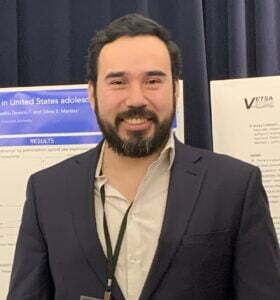Member Insight – Luis Segura
 What sparked your decision to become an epidemiologist?
What sparked your decision to become an epidemiologist?
After finishing medical school in Mexico, graduates have to volunteer for a year as a general practitioner to give back to the community. We call this the medicine social service. I did my medicine social service in the infectious disease department at the Nuevo Leon State University Hospital when the H1N1 flu pandemic hit Mexico. During this time, a professor of infectious disease was the only epidemiologist working at that hospital, so she drafted me into the epidemiology department to help with outbreak investigations, collecting data from patients sick with H1N1, and attending meetings to decide protocols for triage and infection control. It was this experience that sparked my interest in epidemiology as a potential career path.
What do you see as the biggest obstacle facing epidemiologists in the next five years?
I can think of two obstacles. I am not sure if they are big or not but these are things I have been thinking about recently.
The first one relates to the scientific discipline as a whole and that is communication. In the past year and a half, we have seen more public health professionals and epidemiologists in the spotlight due to COVID-19. At the same time, we have seen growing distrust and confusion stemming from a lack of clear communication with the general public about issues like vaccines, masks, risks, etc. I think public health and epidemiology programs could benefit from training on how to communicate research findings to nonscientists.
Second, and this is more specific to epidemiology and causal inference, I have been reflecting a lot on the literature published under what people called the “epidemiology wars”. While epidemiology has made great advances in estimating individual-level causal effects under the potential outcomes framework, I am not sure epidemiology as a discipline has been able respond to the criticism of ignoring causes at the group-level—what Geoffrey Rose called causes of incidence in his seminal paper “Sick individuals and sick populations”. Epidemiology as a public health discipline needs to better address this obstacle.
Do you have any pets?
Currently, I do not have any pets. I did grow up having a lot of different pets like: cats, dogs, birds, parrots, turtles, and even a rooster!
Why did you join SER? What keeps you coming back?
I joined SER because I really like learning about causal inference and its latest developments and applications to different fields in epidemiology. The SER annual conference is a great opportunity to do just that. Also, the SER community has made available wonderful resources to stay up to date with current relevant topics like two very interesting podcasts (Epidemiology Counts and SERious Epi).
What advice do you give students who want to become epidemiologists?
Find good advisors and mentors. They can make a big difference on the journey through a graduate program.
Outside of epidemiology what do you enjoy doing?
I enjoy playing guitar, both acoustic and electric. Also, I have a very diverse taste in music ranging from classic rock, pop (shout out to Taylor Swift fans out there), jazz, and reggae, to the latest top 50. I enjoy the versatility of playing different music styles.
What is something that not many people know about you?
I have played guitar at the Play Station Theater in NY and many other gigs like Rockwood Music Hall, The Mercury Lounge, Pianos, the DROM, The Living Room, etc. I’ve also recorded and mixed music for several local and international artists and some of my guitar collaborations with these artists are on music digital platforms like Spotify.
I am also very into the whole superhero craze (though I see no need to choose between MCU and DCEU! My favorite Avenger is Thor because I think he has the most interesting story arc, from Asgardian jock prince to someone who lost everything and is trying to put his life back together. Also, in my opinion Ben Affleck (Batfleck) is the best live action Batman.
